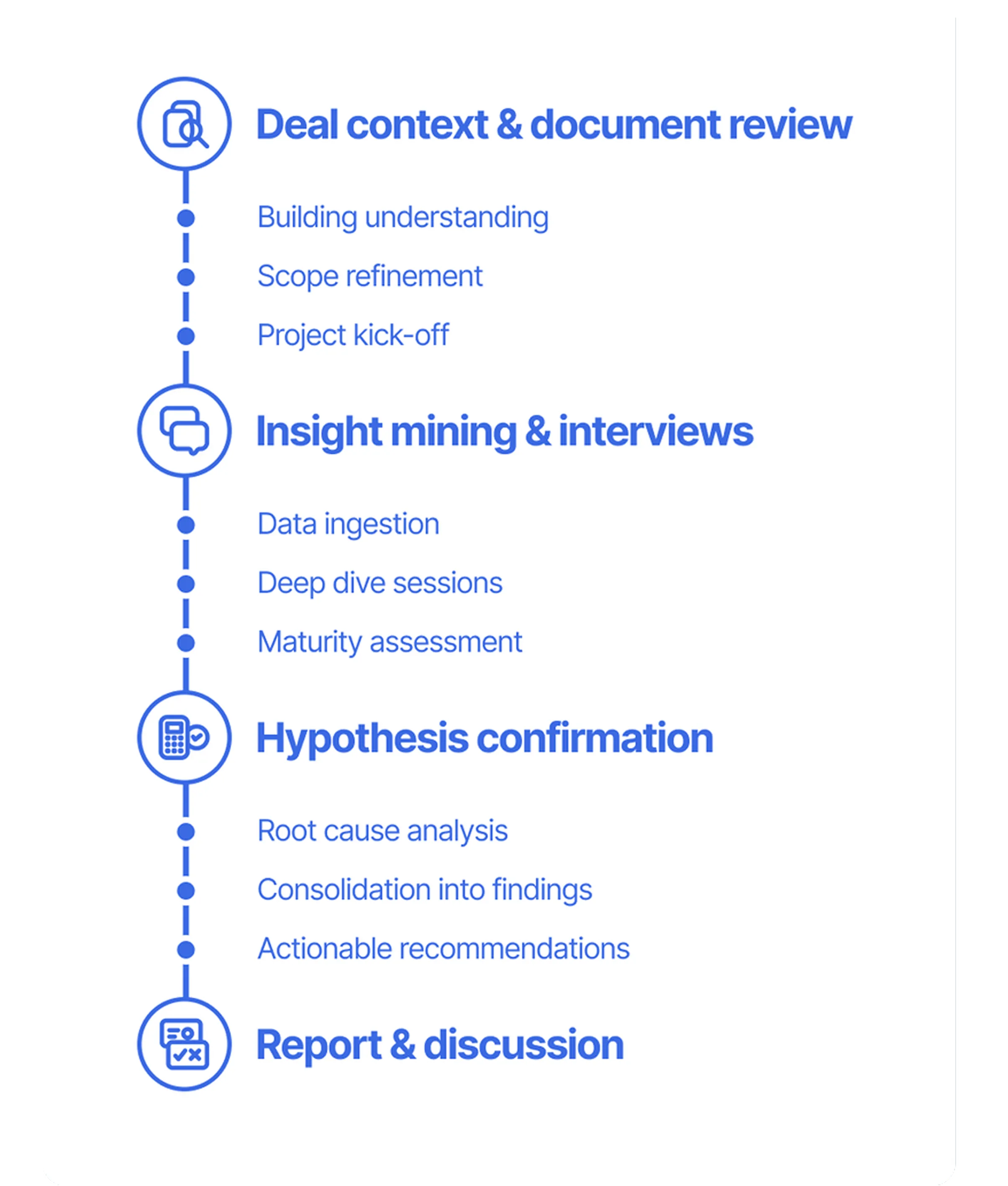You plan to perfom an Tech DD? We are happy to share insighs from our data-driven approach and strong experienced CTOs.
What is a Technology Due Diligence?
The idea is to have subject matter experts (usually former CTOs or CPOs with a strong technology background) inspect all relevant aspects of the technology and product value chain (sometimes also “value stream”). The experts typically uncover a variety of technologically rooted insights that support the investor or other stakeholders in making a fact-based investment decision and to identify value creation levers or even synergies for the time after the transaction.
Investing in technology companies or “tech-enabled” companies involves the classical due diligence work streams such as commercial DD, legal DD and financial DD. But nowadays, these are typically complemented by a Technology Due Diligence a.k.a. “Tech DD” - or to be more precise: Technology and Product Due Diligence. Conducted to ensure that technology and product development setup of a company are sound, it analyzes the impact of technology on the investment opportunity.
You want to know how to choose the right Tech DD provider?
Our Technology Due Diligence Provider 101 Guide will help you to find the right Technology Due Diligence consultant.
Who performs a Tech DD and when?
Buy-Side: Investors Before Funding or M&A
VCs, growth equity, and private equity firms run a Tech DD to understand:
• Risks in architecture, security, scalability, and delivery
• Scalability limits that could cap growth or increase cost
• Value-creation opportunities immediately after the deal
The goal is simple:
Reduce risk, validate the investment case, and surface actions that increase enterprise value.
A strong Tech DD should deliver:
• Red flags (if they exist)
• A clear view of technical maturity
• Prioritized recommendations for post-investment execution (for example: automation steps, process improvements, or better use of data)
Sell-Side: Companies Preparing for Growth or Fundraising
Founders and management teams also commission Tech DD — not for investors, but for themselves. This is often referred to as a technology health check.
Reasons to run a sell-side Tech DD:
• Prepare for an upcoming fundraising or exit
• Increase product development speed
• Resolve scaling bottlenecks
• Improve engineering practices and team structure
• Understand gaps in key roles (like CTO or CPO) as the company enters a new growth stage
Sell-side Tech DD focuses less on “What is the tech?” and more on
How can we operate faster, cleaner, and with fewer risks?
It offers founders actionable insights long before they enter investor conversations and reduces the likelihood of surprises during a deal.
Get in touch
TechMiners can support your Tech Due Diligence process. Let's talk about your needs and expectations.

Which topics should a Technology DD cover?
The range of topics assessed during a Technology Due Diligence can be both varied and complex, and it largely depends on the ultimate goal of the specific DD. While there are an infinite number of approaches and even specific Tech DD checklists to be found, several topics will most likely be covered by most of them. Here’s a high-level overview of areas and topics that TechMiners will typically look at, accompanied by a non-exhaustive set of selected questions we will seek to answer during an assessment:

Depending on a variety of factors that affect deals between investors and acquisition/investment targets (e.g. industry specifics, company stage and market dynamics) , additional analyses are necessary beyond the “typical” scope laid out above. The specific hypotheses, questions and analyses to be carried out should closely mirror both due diligence requirements (what do we need to be sure of?) as well as being integrated with the core scope and the overall maturity rating of the business.
As examples for industry specifics, a Tech DD on a company that handles personal data as a core of their product should contain additional deep dives on security and compliance. A fintech company on the other hand, handling payment transactions, has additional, complex requirements when it comes to (technical) transaction security, business continuity, and API scalability, which obviously influences DD scope.
A business' current development stage also has implications for the DD scope. Clearly, an early-stage venture looking to find product/market fit and employing only few people (sometimes just the founders) requires focus on efficiently creating and evaluating experiments to (dis-)prove and move forward quickly, whereas a growth stage venture has likely confirmed one or several markets for their product. When scaling quickly to secure market share is the central investment goal (and this can also be motivated by market dynamics), a suitable team structure and stable processes, as well as advanced infrastructure automation and quality assurance are key enablers of success.

At TechMiners, we ensure adequate scope early on during kick-off meetings, preliminary research and involvement of industry experts, generating an understanding of the business we are assessing and its individual challenges and opportunities. Our due diligence framework leverages modular of assessment areas and analyses that can be configured to meet the requirements of the case at hand, from a very basic DD focusing on just key insights on core topics up to a full-fletched confirmatory Tech DD with additional deep dive sessions, and expert involvement guided by our data analyses.
Get in touch
TechMiners can support your Tech Due Diligence process. Let's talk about your needs and expectations.

Common risks a Technology Due Diligence should cover
Technology companies face different types of specific risks, with impact on business ranging from cost disadvantages and productivity issues to exposure to security incidents. A Technology Due Diligence should provide insights into what the specific risks are and how impact can be mitigated.
Risks with detailed view that should be covered as part of a Tech DD:

Tech not as scalable as business requires
If the systems and processes your business relies on don’t scale efficiently they will inhibit growth when your product starts to gain traction. You may be forced to turn away new customers, of whom many may never return. Time used developing workarounds for tech that doesn’t scale or re-engineering inefficient tech processes can be better spent developing new features or improving product quality.

Privacy, and GDPR non-compliance
The General Data Protection Regulation (GDPR) is a regulatory requirement of the EU that mandates certain protections are in place to safeguard personal information. Companies are required to take regular GDPR compliance audits. Non-compliance can result in monetary penalties and injunction of business practices.

Technologies used just to push valuation
Keep your tech stack minimal and focus on needs versus wants. Adding unnecessary ‘vanity’ technologies to push valuation or appease developers is a dangerously inefficient use of funds that would be better spent attracting new customers. Furthermore, many of the latest technologies, such as artificial intelligence (AI) fail to deliver marketed value, resulting in substantial asset depreciation.

Inefficient processes and misleading communication
Effective and efficient communications help keep the team aligned and aware without weighing them down in minute details. Is there a structure to getting things done? Is it efficient or overly complex? Unnecessarily complex work models result in procedural deficits that waste capital, demotivate and lead to talent churn.

Mismanaged data strategy
A poorly defined data management strategy represents a lost opportunity to better understand your customers and cohorts. If you understand your customers and cohorts you can market more effectively and reduce customer acquisition costs. A well-defined and managed data strategy enables a higher degree of fact-based rather than feeling-based decision making.

Paralysing Tech Stack
It’s important to select an appropriate tech stack for your business. Inappropriate tech stacks slow feature development and deployment of new releases. Additionally, when selecting solutions, it’s important to be mindful of vendor lock-in. Vendor lock-in ties your company's future to the vendor's abilities and strategy, which may not align with your own.
Summary report as an output of a Technology Due Diligence
Any Technology Due Diligence report will summarize findings and provide a clear understanding of the risks and expected impact connected to them. A detailed picture of the existing product, technology and team as well as the company’s capability to move business forward are also typical and an executive summary will allow the reader to understand all major topics within 2-3 minutes.

The DD’s findings are preferably ordered by expectable impact on the investment case, touching both areas the experts defined as keys to success in which a venture either outperformed expectations (which may provide opportunities for building competitive advantage) or has clear room for improvement. Each finding should be accompanied by a clear description of why this topic is worth mentioning and what evidence can be provided as a rationale. Next, a clear picture of potential impact is required to help investors and other stakeholders understand the weight of each finding, offering a look into the future in the context of the business objectives and investment thesis. Even a setting that works perfectly well today has a high probability of failing when product usage increases 10x, or when a company wants to significantly increase their development FTEs. Without considering the specific objectives, strategy and roadmaps, any tech assessment will lose a significant part of its value.
As the overall assessment depends on multiple factors, a report should also represent some form of GAP analysis, as expectations vary heavily between cases. A finding in one Tech Due Diligence may not be worth mentioning but crucial in the next (e.g. missing ISMS for early stage startup that handles minimal amounts of personal data vs. Series C of a company providing employee benefits, storing data on salaries, social security, etc). TechMiners uses a proprietary maturity model, aiming at an easy-to-understand system for defining expectations for each investment case as well as objective criteria to assess each of our projects with minimal amounts of bias, benchmarking against industry peers wherever possible.
While Tech DD experts may bring sector experience and even benchmarks to support their expectations, they are typically to decide on how to address the identified challenges. Understanding possible impact as well as having received clear and detailed recommendations on how to potentially mitigate these challenges help decision-makers prioritize initiatives and resource allocation, which is why the concluding part of a finding needs to be actionable, specific advice. A professional analyst will provide recommendations from the perspective “If I was the CTO here, what would I do next, how, and in which order?”. Depending on the depth of the DD, these recommendations can range from simple and easy-to-implement tasks like “introduce tool X into CI/CD pipeline to improve delivery speed and confidence” to more complicated initiatives, including re-arranging or introducing entirely new teams. In the best-case scenario, the findings and recommendations are written in a way to be handed over to a company’s CTO without editing and still support his operative work for addressing issues immediately.

Wrapping up a Tech Due Diligence includes a report presentation or “read-out”, offering verbal descriptions and summaries of the project to the mandating party. This is the moment to go deep on specific topics, to clarify open questions and to get the analyst’s lateral observations and opinions. It is also quite common to have a second session with the target company’s key stakeholders, explaining in detail the findings are aiming at and how to address it.
Some Technology Due Diligence providers offer post-transaction technology consulting, leading operative improvement initiatives that address the findings from the DD. While this approach is valid and may provide Investors with efficiency (little handover between transaction work and value creation efforts required), at TechMiners we strongly believe in specializing on the DDs. This is not only for the evident conflict of interest (will the prospect of a “therapy” sale really not influence the “diagnosis”?) but also a deliberate focus of our energy on improving speed, accuracy, and actionability of our Transaction Services to create superior value for all stakeholders involved. Needless to say, our experts are available for questions regarding recommendations or other parts of the report and we regularly offer “CTO sparrings” to former collaborators to provide a second opinion, connect them with the right experts and to discuss approaches, ideas and advice. After all, we love seeing tech companies succeed and build amazing technology, so we are more than happy to contribute to such missions.
Are you planning to invest in a tech company and unsure about how to approach your Technology and Product Due Diligence?Do you run a venture heading towards a funding round that will likely involve a Tech DD?Does your business model heavily rely on technology and you want to do a “health check” on how you are doing technologically?
Get in touch
TechMiners can support your Tech Due Diligence process. Let's talk about your needs and expectations.

Technology Due Diligence checklist
A Technology Due Diligence can be a stressful process as it doesn't happen regularly, takes place during a limited time frame (has a high time pressure) and occurs while the daily business needs to continue as normal.Depending on the scope of the Technology Due Diligence the preparations can be completed within a few minutes or might require intense work. This is influenced by things like your current level of documentation and technical debt. One useful tip to consider is to always ask for the scope and expected timeline before the Tech DD starts.

Regardless of when the (next) Tech Due Diligence in your organization will take place and of who the Tech DD provider will be, you can already start to prepare a few things to make the process smoother for you and your team.
4 items to have on your checklist:
Have a product demo ready
A vision of the product and a feature comparison list may help the reviewer.
Assemble the most important KPIs
If you can provide time-line charts for those metrics that shows improvements, share them.
Collect essential documentation
Ensure access to your data
We’ve created a detailed Technology Due Diligence Checklist that should enable you to be ready for any Tech DD. This is the ultimate checklist and guide for founders and CTOs, based on >120 Tech DDs completed by our battle-tested CTOs.
Our checklist contains items which covers all aspects relevant in a Tech Due Diligence, from Tech, Team, Product to Scalability.
Whether you and your company are preparing for a Tech Due Diligence which will take place soon, or whether you just want to ensure your organisation is in great shape for when it does happen in the future, using a checklist can be invaluable. A Technology Due Diligence checklist can help confirm that you have prepared for and considered all pertinent factors.
A comprehensive Tech DD checklist can help you:
- Prepare and collect all the appropriate documents and data e.g. IP contracts, software licenses, contracts, diagrams, etc.
- Evaluate the status and quality of your technology stack and your development team and make improvements where appropriate
- Get ready for technical assessments by and interviews with potential investors or acquirers
- Foresee potential vulnerabilities or risks, and address them
- Summarise the benefits and strengths of your technology assets and communicate this with potential investors or acquirers
Data-driven Technology Due Diligence
Through the analysis of factual information (such as software code, development process, documentation, and IT infrastructure) rather than intuition, data-driven approach in a Technology Due Diligence process allows for an unbiased assessment of a company's current state, including areas strengths and weaknesses.
Using this approach, analysts can effectively harness the power of data analytics and data science, complemented by their own experience and expertise, to yield valuable insights and make informed conclusions. This ultimately enables investors and buyers to make well-informed decisions based on factual evidence, supported by the analyst's know-how and proficiency.

Outdated dependencies
Having outdated dependencies (third-party libraries) can result into Increased vulnerability to cyber attacks to old known bugs in dependencies (e.g. Log4j vulnerability) as well as increased maintenance overhead. The chart below displays that more than 40% of third-party dependencies require major version updates, suggesting that the team needs to step up their efforts in monitoring and updating dependencies.
Origin of data: Source code

Bug/ticket ratio
A higher ratio of bugs to other ticket types can be an indication of a potential decrease in the overall quality of the system, leading to higher maintenance and support costs and ultimately reducing user satisfaction.
As shown in the chart below, there has been a consistent increase in the ratio of bugs to tickets over the last 12 months. This suggests that the team should take action to address the root causes of these issues (e.g. code quality, testing, communication, etc.) in order to improve the quality of the system and maintain user satisfaction.
Origin of data: Ticketing system

Team workload
Heavy workload on employees can cause various negative effects including reduced productivity, decreased quality of work, and burnout risk.
The chart provided displays the activity levels of top developers on weekdays within the past 12 months. It highlights that one of the developers (dev1) is consistently overloaded on weekends. This ongoing pattern should be addressed by the company by implementing measures to redistribute workload of that developer among other team members.
Origin of data: History of source code, Ticketing system + documentation system



















